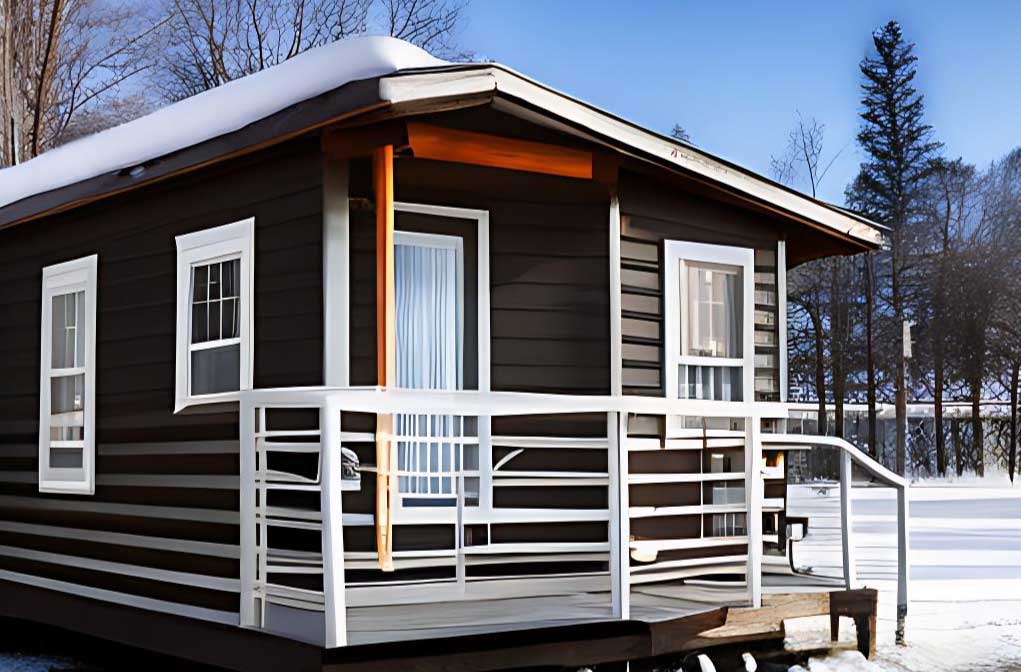Winter is a season that comes with many challenges, this is especially true if you own a mobile home. Cold weather can damage plumbing, cause leaks, and for some lead to the formation of mold if not repaired properly. This is why winterizing your mobile home for your region is critical before the winter months are here.
What is Winterizing a Mobile Home Exactly?
Mobile home winterization is the process of preparing your home for the winter months so that it remains safe and comfortable throughout the season. This involves a variety of tasks, including insulating pipes, sealing doors and windows, inspecting the furnace and water heater, and protecting against moisture and mold.
Why Inspect, Seal, Insulate, and Caulk Your Mobile Home for Winter?
- Protects against freezing pipes.
- Prevents leaks and moisture damage.
- Reduces the risk of mold growth.
- Increases energy efficiency.
- Helps maintain the value of your home.
What You Need to Know to Properly Winterize Your Manufactured Home
Before you start winterizing your mobile home, it is important to understand what the process entails and what you will need. Here is what you need to know:
- Inspect your home for damage.
- Check your pipes and make sure they are properly insulated.
- Seal windows and doors to prevent air leaks.
- Install weather stripping on exterior doors.
- Caulk around windows and doors.
- Clean gutters and downspouts.
- Insulate attics and walls.
- Inspect the skirting.
How to Winterize Your Mobile Home Step by Step
Since we can all agree that winterization is important, here is a step-by-step guide to help you get started:
- Inspect Your Home: Before you start winterizing your home, it is important to inspect it for any damage or disrepair. Look for any cracks, holes, or leaks, and make repairs as necessary. This includes the exterior such as siding and soffit in addition to the other items mentioned below.
- Insulate Pipes: Cold weather can cause mobile home plumbing to freeze, which can lead to leaks, burst pipes, and other damage. To prevent this, make sure to properly insulate all water pipes in your home, including those that run through unheated areas. Heat tape can be used for any areas that are at high risk.
- Seal Windows and Doors: Leaks in windows and doors can cause cold air to enter your home, reducing its energy efficiency. To prevent this, use caulking and weather stripping to seal any gaps.
- Install Weather Stripping on Exterior Doors: Weather stripping helps prevent cold air from entering your home through exterior doors. This is an easy and affordable way to improve the energy efficiency of your home.
- Caulk Around Windows and Doors: Caulking around windows and doors is another simple way to reduce air leaks. It helps keep cold air out and warm air in, which can help lower your heating bills.
- Clean Gutters and Downspouts: Cleaning your gutters and downspouts before winter can help prevent moisture damage to your home. It is important to make sure these systems are functioning properly to prevent water from backing up and damaging your home.
- Insulate Attics and Walls: Insulating your attic and walls can help reduce heat loss in your home, making it more energy efficient. This is especially important in mobile homes, which often have limited insulation.
- Inspect the Skirt: Look for missing or damaged areas. Repair and close up the area as best you can. Mobile home skirting on your home serves many purposes. When it comes to winter weather, it serves as a valuable insulator. It cuts down air gaps and also serves to insulate the plumbing under your home.
In addition to preparing your home for winter, you will get the added benefit of saving on energy costs as well as keeping your home much more warm and toasty.
Cost to Winterize a Mobile Home
The cost of winterizing your manufactured home will depend on several factors, including:
- Size of the home: Larger homes will require more materials and more labor, which will drive up the cost of winterizing.
- Type of insulation: The type of insulation in the home will impact the cost of winterizing. If the home is poorly insulated, additional insulation may need to be added, which will increase the cost.
- Age of the home: Older homes may require more extensive winterizing to ensure that they are energy efficient. This could include updating windows, and doors, or adding more insulation.
- Climate: Winterizing a mobile home in a cold climate will require more work than winterizing a home in a milder climate.
In general, the cost of winterizing manufactured housing can range from a few hundred dollars to several thousand dollars, depending on the factors mentioned above. It is always recommended to get quotes from several contractors to compare prices and get the best value for your money.
Mobile Home Winterization Checklist
| Checklist Item | ☑ |
|---|---|
| Avoid using kerosene heaters to prevent fire and suffocation. | ☐ |
| Buy extra furnace filters and replace them frequently during heating season. | ☐ |
| Caulk around exterior windows and doors. | ☐ |
| Check the security of the skirting around your home’s base. Add insulation for added protection from cold and wind. Block all entry points to prevent damage to the underbelly or ductwork from small animals. | ☐ |
| Check underbelly insulation for open areas and repair any water leaks. | ☐ |
| Check water heater for cracks and leaks. | ☐ |
| Clean gutters to avoid water buildup, roof damage, and interior ceiling damage. | ☐ |
| Consider upgrading to a programmable, energy-saving thermostat for improved efficiency. | ☐ |
| Ensure functional heat tape covers pipes. | ☐ |
| Fix broken window glass. Use storm windows if needed. Replace single-pane glass with energy-saving vinyl thermopane windows to prevent drafts. | ☐ |
| Inspect and repair roof damage, including shingles and tar around stacks and vents. | ☐ |
| Install CO and smoke/fire detectors with working batteries. | ☐ |
| Install leaf guards and downspout extensions on gutters. | ☐ |
| Maintain metal roofing, repair seams and edges, and coat entire roof with premium grade coating. | ☐ |
| Open closet and cabinet doors for proper air circulation. | ☐ |
| Remove garden hoses and check water faucets for proper slope to prevent freeze-ups. | ☐ |
| Schedule a furnace inspection. Reach out to a heating/HVAC expert for a yearly check-up, which can potentially save your life. | ☐ |
| Seal doors and windows with insulation or weather stripping to prevent heat loss and cold air infiltration. | ☐ |
| Seal ducts with tape, butyl (mastic) or both. | ☐ |
| Set interior temperature above freezing and allow faucets to drip slightly when going on vacation or when expecting severe cold weather. | ☐ |
Frequently Asked Questions on Mobile Home Winterization
Common questions we get via email and social media!
How do you keep your pipes from freezing in a mobile home?
Generally speaking, the below suggestions are universal. They apply to both stick-built homes and manufactured homes. Unfortunately, manufactured homes are often more susceptible to freezing due to their design. To get ahead of the problem consider the following tips:
- Insulate pipes: Wrap pipes with insulation material, especially those that are located in unheated areas, such as attics or crawl spaces.
- Seal air leaks: Seal any air leaks around doors, windows, and electrical outlets to keep cold air out.
- Keep a steady temperature: Keep the temperature inside the home above 55°F, even if you will be away for an extended period of time.
- Allow for warm air circulation: Open cabinet doors to allow warm air to circulate around pipes located in exterior walls.
- Disconnect outdoor hoses: Disconnect outdoor hoses from outdoor spigots and turn off the water supply to these spigots.
- Use heated tape or cables: Use heated tapes or cables on pipes that are susceptible to freezing, especially those located in unheated areas.
How long does it take to winterize a mobile home?
The time it takes to winterize a mobile home can vary greatly depending on the size of the home, the number of pipes and appliances that need to be protected, and the type of winterizing that needs to be done.
For an average-sized mobile home, winterizing can take anywhere from a few hours to a full day or more. If the home requires extensive winterizing, such as adding insulation, repair of skirting, or updating windows, it can take several days or more.
At what temperature do pipes freeze in a mobile home?
Pipes in a mobile home can freeze when the temperature outside is at or below freezing (32 degrees Fahrenheit, which is the freezing point of water). Your home can serve to keep plumbing warmer than the outside temperatures. Keep in mind that the risk of pipes freezing is not limited to temperatures in your home nearing below freezing, as pipes can freeze when the temperature inside the home is in the high 30s, 40s, or even 50s depending on the temperature outside.
It is important to take steps to protect your pipes from freezing, even if the temperature inside your home is above freezing. This is because the longer pipes are exposed to cold temperatures, the greater the risk of them freezing.

